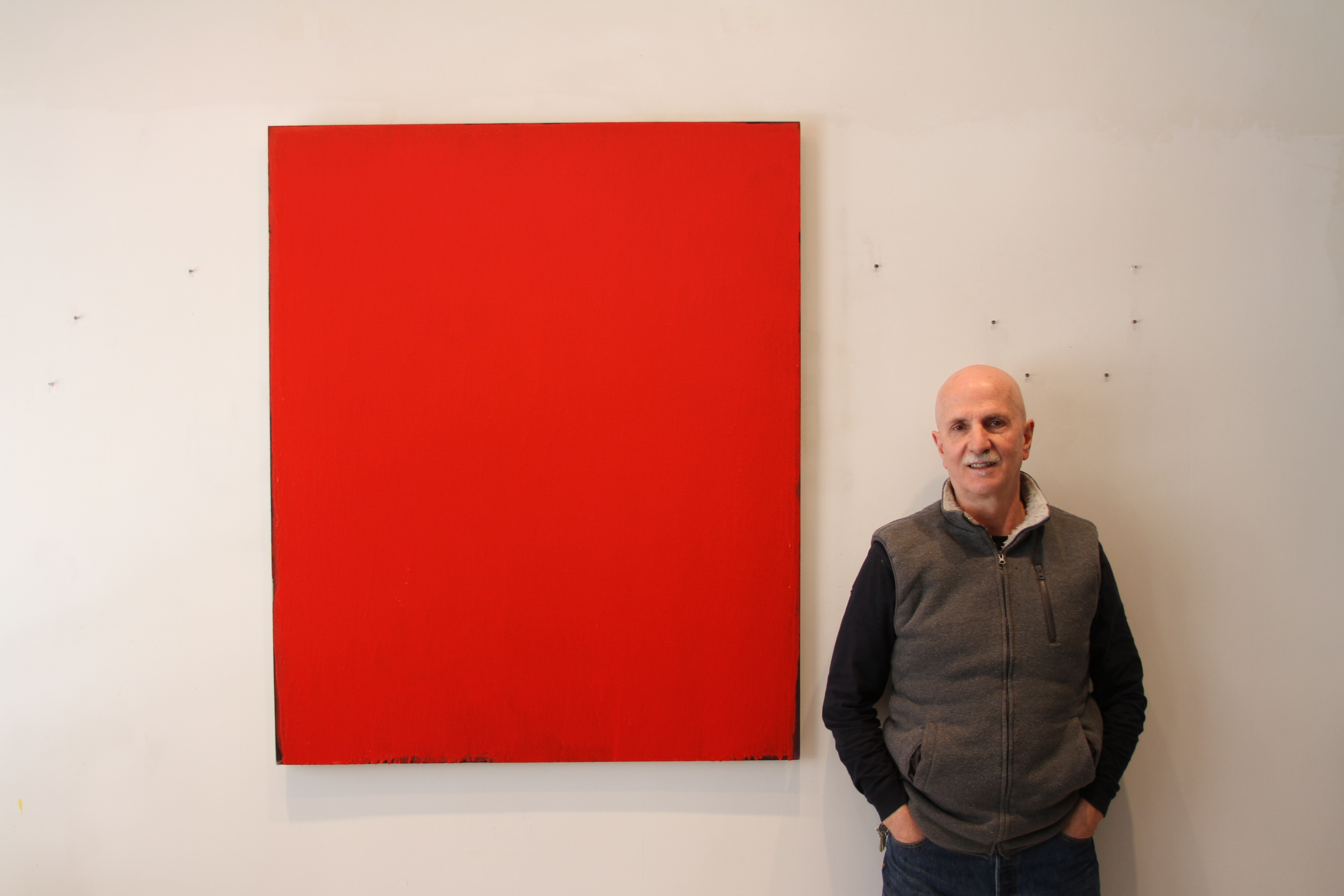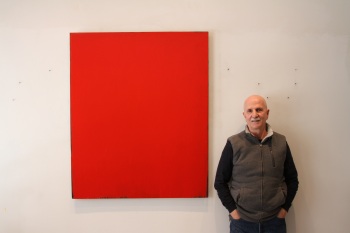Painter Joseph Marioni next to one of his recently completed works.
By Bryan C. Kuriawa
Above the busy streets of Manhattan, he spends his mornings reading through books about the history of art. Surrounded by a library compiling his favorite artists, his colleagues, and his own work, he plans for the day ahead.
Two floors above in his studio, he creates a painting composed of multiple layers, but one final color. The emphasis in each being of one color, as specific to that color as possible, and to that of light. Such a straightforward piece of art, in truth encompasses more to the viewer than imagined.
Since 1970, Joseph Marioni has set about forging his own identity in the world of art. His multi-layered, yet ultimately single-color, paintings have gained praise both overseas and in his own backyard.
Despite being considered an abstract or minimal painter, Marioni would instead classify himself as a “Radical Painter.” Within this context, the act of painting itself becomes his immediate and direct objective.
“It’s painting of sensation, not painting of information, the painting is not trying to give you information, it’s trying to give you sensation,” Marioni said. “It doesn’t have a picture, narrative, it doesn’t have a story, there’s no picture language in the painting.”
Born in 1943, the son of a doctor and opera singer, Marioni first introduction to art came during childhood. Sitting in his father’s library, he would look at various large art books detailing the history of Renaissance painting.
Viewing them, he was distinctly influenced by the color of these works seeing them as the most beautiful form of “eye candy.” From these paintings, Marioni decided his future profession was to be a painter.
With the post-war Abstract Expressionists being among the most popular painters, Marioni would begin to view their work in similar standing. Seeing those of Pollock, Rothko, and Newman as modern influences, he moved to New York to pursue his dream.
Yet upon arriving, Marioni arrived in the midst of an artistic transition that influenced his work.
“I came to New York at the peak of people like Bob [Robert] Ryman and Brice Marden, two of my colleagues, and the issue was the literalness of their work,” Marioni said. “The question is what is the difference between something that is real and something that is merely literal, and the basic difference is the distinction between object-hood and objectness.”
In developing his own distinct style, Marioni stressed the reality of this matter, but saw what he creates as “Real Paintings” devoted to objectness.
In this, it portrays the essence of painting, to carry pigment which carries light or as he dubs, “Liquid Light.” Yet beyond the act of painting, he feels such a term carries a philosophical weight which goes into the essence of an object.
“Our eye and brain [have] not developed enough for us to recognize light, we don’t recognize light,” Marioni said.
“What we recognize is the object that the light is reflected off of. The light has to divide up into its components in order for us to see it, so our consciousness doesn’t recognize the light itself in the pure form. It recognizes what I call the children of the light, the angels of the God of light. We have the most mundane names for them; we call them green, yellow, red and blue.”
In this principle, Marioni feels that individuals have never asked about the philosophical undertones of his work.
Instead, he believes the critic is there to promote their agenda, in which this topic may be unfashionable. To that extent, Marioni feels there are certain terms not addressed by writers in discussing art due to historical “baggage.”
“Quality, beauty, spiritual, they’re taboo,” Marioni said. “They are the three things Western Civilization categorizes as useless.”
To Marioni, these subjects are ignored by modern art critics when it comes time to write their articles. In such cases, critics, and subsequently gallery curators, are more interested in projecting their social agendas rather than something broader.
While he is established in Europe, Marioni has only recently been gaining notice as a painter in the United States.
In 2011, he was featured as part of the gallery, “Eye to Eye” at the Phillips Collection in Washington D.C. Paired with the works of Vincent Van Gogh, Piet Mondrian, and others, Marioni’s work became the exhibit’s centerpiece.
“Marioni is a truly erudite painter dedicated as much to the process and materials of painting as to the intellectual ideas behind the medium,” Vesela Sretenović, Senior Curator of Modern and Contemporary Art said.
“His desire to paint light and the immaterial yet in a very concrete manner, with sheer color, puts him in between the physical and meta-physical, a place where he can happily reside as being simply and truthfully himself: a “painter.”
Although in his eyes, his recent prominence in America comes in a time of a different popular art form.
“America is not interested in painting anymore, it’s not our cultural identity, what is our dominate art-form? It’s filmmaking,” Marioni said. “The United States is shifting its cultural identity from the East Coast to the West Coast, it may take another 20 or 30 years, and then the United States will emerge with a dominate art-form which will be filmmaking.”
Yet in terms of painting, Marioni stated one day, we will have artists who are just painting simply red or blue paintings. In this, there will be a progress of art in the future as have occurred with different forms transforming into branches of abstract art.
Beyond any transitions that may happen, Marioni feels art will still remain prominent. Whether on an easel, or in another form, he believes it will remain and address more than the image.
“Painting is the medium of the human spirit,” Marioni said. “I make paintings that address the human spirit.”
For more information, visit Mr. Marioni’s website at http://home.tiac.net/~marioni/
Editor Anthony Muccigrossi contributed to the reporting of this article.

